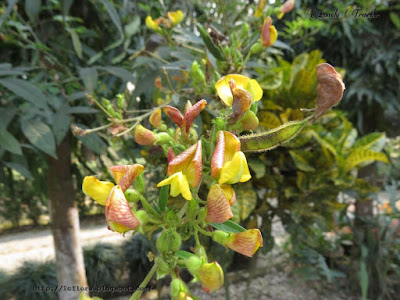| Common Name : | Pigeon pea. |
| Binomial Name : | Cajanus cajan |
| Family : | Fabaceae |
| Bangla Name : | Arhar (অড়হর), Adhad |
| Photo Taken : | Bangladesh |
Cajanus cajan, commonly known as pigeon pea or red gram, is a fascinating legume plant that belongs to the Fabaceae family. Its botanical name, Cajanus cajan, reflects its unique characteristics and widespread cultivation. Native to the Indian subcontinent, pigeon pea has been cultivated for centuries and is now grown in various parts of the world.
Pigeon pea is a perennial shrub that can reach heights of up to 4 meters. It has a woody stem with branches that spread out widely. The plant features compound leaves with three leaflets, which are elliptical and have a smooth texture. The leaves are arranged alternately along the branches, providing an attractive and lush appearance to the plant.
Pigeon pea produces beautiful and vibrant flowers. The flowers are typically yellow, although variations with orange, red, and white hues can also be found. The flowers are arranged in clusters at the ends of the branches. Each flower consists of five petals, with one larger upright petal known as the banner, two lateral petals called wings, and two fused lower petals forming the keel. This unique arrangement gives the flower a distinct shape and enhances its aesthetic appeal.
Pigeon pea has a long history of human utilization and offers various uses. The plant is primarily cultivated for its nutritious seeds, which are rich in protein, dietary fiber, and essential minerals. These seeds are commonly used in cooking, particularly in traditional dishes of many cultures. Pigeon pea seeds can be consumed fresh or dried, and they are often incorporated into soups, stews, curries, and side dishes. Additionally, the leaves of pigeon pea are also edible and can be used as a nutritious vegetable in various culinary preparations.
Beyond its culinary uses, pigeon pea has several other valuable applications. The plant is known for its nitrogen-fixing abilities, which makes it an excellent choice for improving soil fertility. In many agricultural systems, pigeon pea is grown as a cover crop or intercrop to enhance soil health and promote sustainable farming practices.
Photos of these Pigeon peas (Cajanus cajan) were taken from Botanical Garden, Dhaka, Bangladesh. It was during february 2015 (a day of the very first day of the spring).
Written by Lonely Traveler,
For blog icflora.blogspot.com





Comments
Post a Comment